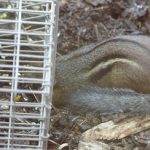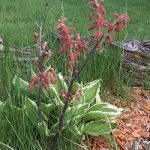by Winding Pathways | May 28, 2017 | Mammals, Nature
Our dining room table overlooks a tiny pond circled with large stones. Many wild animals come to drink or bathe. One of our favorites is the sleek Eastern Chipmunk. Often, chipmunks fill their cheeks with seeds that fall from our bird feeders and carry them off to a stash.

This chipmunk figured out how to tunnel under the trap to get the seeds.
One summer we watched a clever chipmunk problem-solve how to access seeds from a live trap without getting trapped itself. The ingenious chipmunk tunneled under the trap and up through the wire, helped itself to the food and returned back out the tunnel to store its treasure for later eating.
We love chipmunks but many people utterly hate them and ask us how to rid their yard of the tiny mammals. Although they can undermine rock walls by tunneling otherwise chipmunks do slight damage. They are most commonly found in shady yards with woodpiles or rock walls.
Chipmunks may be unusually numerous in suburban yards because people discourage their predators. Bull snakes love dining on tasty chipmunk dinners but few homeowners want a six or eight-foot-long snake sharing their yard. Many hawks also devour chipmunks but, like snakes, they aren’t common in town. So, these small rodents have few predators to fear other than marauding house cats.
An effective way to keep chipmunk numbers in control is to encourage predators. If snakes can’t be tolerated, removing woodpiles and rocks will eliminate chipmunk homes.
Occasionally chipmunks and white footed mice climb into vent pipes plumbing or clothes dryers. An easy way to discourage them is to buy a few stainless-steel scrub pads sold in most grocery stores. These are balls of coarse, somewhat sharp metal. Put the pad in the pipe in a way that fills the void but doesn’t cause the pad to compress much. It acts like a filter, allowing air to move through it but not letting rodents pass.
But, mostly just enjoy your chipmunks.
by Winding Pathways | May 21, 2017 | (Sub)Urban Homesteading, Foraging, Nature, Trees/Shrubs
This is a tale of free trees. Our friend, Marilynn Keller, learned how to plant the best tree species in her yard at no cost and with little work.
She simply didn’t mow a tiny area of lawn where she wanted a tree to grow. As if by magic, a White Oak, Sugar Maple, and Shagbark Hickory sprouted there this spring. Although the spot is too small for three trees Marilynn can simply decide which one she wants and mow the others off.

Likely a squirrel buried a nut that has sprouted.
Last fall an industrious squirrel gathered acorns and hickory nuts and buried them in her yard. The squirrel might have forgotten his hidden cache or perhaps died. Either way the unrecovered nuts sprouted.
Although squirrels often eat maple seeds, it’s most likely that Marilynn’s baby maple sprouted because a gust of wind pulled the ripe seed off a nearby tree and it helicoptered to her yard.
While Maples are usually easy to transplant, and are widely sold by nurseries, not so Hickories. Although any of the many Hickory species make outstanding shade trees, as soon as a nut sprouts it sends an enormous taproot deep into the ground. Moving a hickory is difficult and often unsuccessful. Commercial nurseries avoid them.
The same goes for white oaks, one of our favorite trees. It’s difficult to buy one to plant in the yard. Because they are slow growing and challenging to transplant, few nurseries bother with them. Fortunately, they readily sprout on their own.

In autumn Maples glow with color.
Anyone living where there are mature Hickory, Oak, or Maple trees nearby can use Marilynn’s tree planting method. Simply don’t mow a patch of lawn where a tree is desired. Odds are one will appear on its own next spring. If more sprout than the spot can support just mow the others off and put wire screening around the new tree to protect it from hungry cottontails and deer.
If a tree sprouts in the wrong place it can be easily transplanted with just one shovel of dirt. Move it before the tiny tree has grown a long taproot.
by Winding Pathways | May 19, 2017 | (Sub)Urban Homesteading, Garden/Yard
Nature is not all sunshine and roses, cute baby animals and gentle breezes. Sometimes nature is rough, sometimes vicious, sometimes other creatures simply clean up carcasses of fallen animals. This spring the Heartland has had its share of hail, winds and heat. The front yard maples and Phoenix Harmony Labyrinth’s budding Bur Oak survived by bending with the winds. With the variable weather comes casualties. The last video graphically shows the scavengers cleaning up a fawn carcass that showed up on the back lawn after a night of cold, wind, and heavy rain. It’s sad but we have to remember than Mother Nature’s clean up crew will benefit from the loss. And, life goes on.
by Winding Pathways | May 16, 2017 | (Sub)Urban Homesteading, Garden/Yard, Nature, Trees/Shrubs
We never spray our lawn at Winding Pathways. Occasionally, that yields an exciting discovery like what happened in early May.

Rich shows the tiny oak seeding.
We wanted to plant a tree, preferably an oak, on the south side of our garage. But, we got busy and never found time to buy or plant one. One morning Rich, while walking across the lawn to fetch the morning newspaper, spotted a baby white oak tree that sprouted exactly where we wanted to plant one. It was serendipity.
Seed Banks”
Plant ecologists talk about the “seed bank.” In land that hasn’t been greatly disturbed by plowing, spraying or compacting of soil, seeds of desirable native plants often remain dormant in the soil for years or decades. Then, when conditions are right they’ll sprout like magic. Other desirable plants spread their seed through the wind or enlist the help of a hungry squirrel to carry and bury a nut or acorn. That’s probably how our new oak got planted.
Before mowing walk across your unsprayed lawn. You may discover a plant you want that is starting to grow. Just mow around it to let it thrive. Mark it with a stake or fence it off from rabbits and deer. If the plant is not quite in the right place, remember that tiny plants are usually easy to move with just a shovel full of dirt.

We protect volunteer trees that grow where we want them.
About seven years ago we found another baby oak in our lawn. We protected it from mowing and ran a screen around it to keep hungry deer away. It’s now about seven feet tall and growing rapidly.
That black oak didn’t cost a penny and will grace our yard long after we’re gone.
Another way to go about natural or plant and wildlife friendly yards is to deliberately plant certain forbs and grasses to attract a variety of beneficial insects and interesting birds and other wildlife.
by Winding Pathways | May 15, 2017 | (Sub)Urban Homesteading, Foraging
Chicks are amazing! How quickly they learn and adapt. Their personalities amuse us at Winding Pathways and their problem solving is the best! Enjoy the videos of the Hoover’s Hatchery chicks at about ten weeks.





